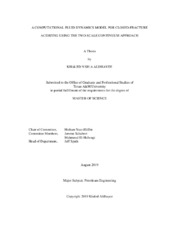| dc.contributor.advisor | Nasr-El-Din, Hisham | |
| dc.creator | Aldhayee, Khaled N SH A | |
| dc.date.accessioned | 2019-11-25T21:36:39Z | |
| dc.date.available | 2021-08-01T07:32:25Z | |
| dc.date.created | 2019-08 | |
| dc.date.issued | 2019-07-10 | |
| dc.date.submitted | August 2019 | |
| dc.identifier.uri | https://hdl.handle.net/1969.1/186461 | |
| dc.description.abstract | Closed-fracture acidizing (CFA) is a well stimulation technique that can be applied to stimulate carbonate reservoirs at the end of acid fracturing treatment to enhance the connectivity between the acid-fracture and the wellbore. In CFA, acid is injected in the closed-fracture at rates lower than the fracturing pressure to dissolve the minerals that exist in the fracture; hence, it enhances the fracture conductivity. Etching of fracture surfaces and propagation of wormholes from the fracture are often associated with CFA operations. The objective of this study is to develop a robust model that can capture the dissolution process and wormholing phenomenon that occur during CFA. In this work, CFA model is developed using computational fluid dynamics (CFD) techniques coupled with the two-scale continuum model that can predict accurately the reactive flow mechanisms of hydrochloric acid (HCl) in carbonate formations. Multiple CFA models are constructed and populated with the actual porosity distribution profiles of calcite and dolomite formations. Then, the developed model is validated using the results of the experimental work done on the API fracture-conductivity apparatus. Sensitive analysis is carried out for several parameters that affect the performance of CFA in carbonate formations. Two-scale continuum model has successfully captured the dissolution patterns and wormholing phenomenon that occur in the CFA through the model validation study. Several parameters have been investigated to study their effects on CFA operation in calcite and dolomite formations. Acid injection rate and concentration contribute significantly to the performance of CFA in calcite formation that exhibits the diffusion-controlled reaction regime. On the other hand, high acid concentration needs to be injected in dolomite formation for an efficient stimulation job. Well geometry, formation permeability, and fracture conductivity have great effects in controlling the acid flow in the medium and the acid leakoff process that induces wormholes in the domain. The developed CFD model was able to predict the performance of CFA in carbonate formations that exhibit degrees of heterogeneities and natural fractures. The model was upscaled to establish a qualitative relationship that can relate the acid volumes of CFA used in the model and in an actual acid-fractured well. | en |
| dc.format.mimetype | application/pdf | |
| dc.language.iso | en | |
| dc.subject | Closed-Fracture Acidizing | en |
| dc.subject | Acid Fracturing | en |
| dc.subject | Well Stimulation | en |
| dc.subject | Reactive Flow Modeling | en |
| dc.subject | Computational Fluid Dynamics | en |
| dc.title | A Computational Fluid Dynamics Model for Closed-Fracture Acidizing Using the Two-Scale Continuum Approach | en |
| dc.type | Thesis | en |
| thesis.degree.department | Petroleum Engineering | en |
| thesis.degree.discipline | Petroleum Engineering | en |
| thesis.degree.grantor | Texas A&M University | en |
| thesis.degree.name | Master of Science | en |
| thesis.degree.level | Masters | en |
| dc.contributor.committeeMember | Schubert, Jerome | |
| dc.contributor.committeeMember | El-Halwagi, Mahmoud | |
| dc.type.material | text | en |
| dc.date.updated | 2019-11-25T21:36:39Z | |
| local.embargo.terms | 2021-08-01 | |
| local.etdauthor.orcid | 0000-0002-7823-198X | |


